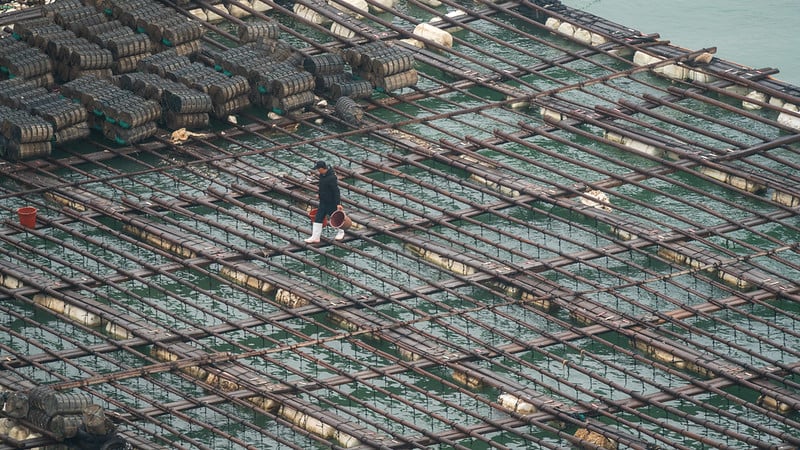
In a groundbreaking endeavor, scientists at the University of South Australia have devised an innovative solution to tackle the pressing challenges of freshwater scarcity and food production.
They have introduced a pioneering concept of vertical sea farms floating on the vast ocean expanse, making use of two abundant and cost-free resources: the sun and the sea.
In what is being hailed as a unique achievement, these researchers have ingeniously crafted a self-sufficient system powered by solar energy. This system performs a remarkable feat—it transforms seawater into freshwater and cultivates crops, all without requiring any human intervention.
The implications of this invention are profound, as it holds the potential to alleviate the impending global crises of dwindling freshwater supplies and insufficient food production. With the world’s population projected to soar to ten billion by 2050, initiatives like these are critical for a sustainable and healthy future.
Vertical floating sea farm
Professor Haolan Xu and Dr. Gary Owens, distinguished scientists at the University of South Australia’s Future Industries Institute, have unveiled their groundbreaking creation: the vertical floating sea farm.
“The system works much like a wicking bed that household gardeners might be familiar with,” said Dr. Owens.
Explaining the system’s operation, Dr. Owens draws a parallel with a concept familiar to household gardeners—the wicking bed. However, this innovative approach involves a unique twist.
A multitude of solar evaporators is responsible for drawing in seawater, capturing the salts within the evaporator structure. Under the intense rays of the sun, these devices release purified water vapor into the atmosphere.
Subsequently, this vapor condenses on water belts and is transported to the upper plant growth chamber.
In a compelling real-world demonstration, these researchers cultivated three commonly consumed vegetable varieties—broccoli, lettuce, and bok choy—entirely using seawater surfaces. The remarkable thing about this is that this entire process required no human intervention, maintenance, or additional freshwater irrigation.
Powering of the sea farm
Professor Haolan Xu highlights the unique advantages of their solar-powered sea farm system compared to other ongoing trials. In their innovative design, evaporators are strategically positioned outside the plant growth chamber.
This smart layout preserves valuable space within the growth chamber for crops and minimizes the risk of overheating and crop loss, which can be an issue in alternative designs.
Floating farms, utilizing traditional photovoltaic panels for electricity to run desalination units, have also been suggested in the past. However, these systems are both energy-intensive and financially burdensome to maintain.
Unique features of the farm and prospects
The distinguishing feature of their creation is their vertical arrangement of evaporator and growth chambers, resulting in a smaller overall footprint and optimized area for food production.
Moreover, the system operates with remarkable efficiency, harnessing the power of solar energy and seawater alone to produce clean water and cultivate crops. It’s fully automated, cost-effective, and user-friendly.
Dr. Owens emphasizes that their current model serves as a proof-of-concept, and their vision is to scale it up. By deploying a cluster of individual devices, they aim to boost plant production, addressing larger food supply demands.
In the foreseeable future, we might witness vast farm biodomes floating on the ocean or numerous smaller devices dispersed across expansive sea regions.
As part of their ongoing efforts, the team plans to enhance the prototype’s capability to yield more biomass. This may involve incorporating cost-effective materials like waste rice straw fiber, further lowering operational costs and advancing sustainability.
Purity of the water
The research team has demonstrated that the water generated through this process is not only safe to drink but also boasts lower salinity levels than what the World Health Guidelines recommend for drinking water quality.
According to the United Nations, a staggering 2.4 billion individuals could face water scarcity by 2050. Simultaneously, the global water supply for agricultural irrigation is projected to decrease by approximately nineteen percent during the same timeframe.
A floating farm? The Netherlands is pioneering floating dairy farms in response to land shortage and rising sea levels. Cows on water might be the future of sustainable agriculture. pic.twitter.com/yrmMSKMw3L
— Knowledge Brain (@manbaua) September 3, 2023
Dr. Owens highlights the stark reality that freshwater constitutes a mere 2.5 percent of the world’s total water resources, and much of it remains inaccessible, locked away in glaciers, ice caps, or deep underground.
This scarcity is further exacerbated by the escalating demands stemming from population growth and climate change.
The compelling aspect of this innovative approach is that it taps into the vast resource of the world’s oceans, which hold a staggering 97.5 percent of the planet’s water—abundant and readily available.
Leveraging the sea and the sun to combat the ever-mounting global shortages of water, food, and arable land presents an evident and practical solution.
Widespread adoption of this technology has the potential to significantly enhance the well-being and livelihoods of billions of people worldwide.
See all the latest news from Greece and the world at Greekreporter.com. Contact our newsroom to report an update or send your story, photos and videos. Follow GR on Google News and subscribe here to our daily email!



